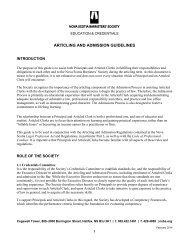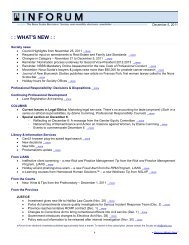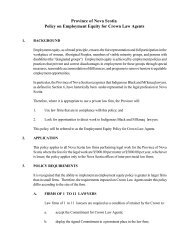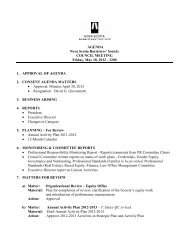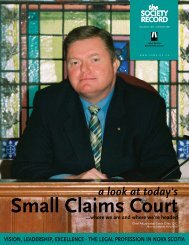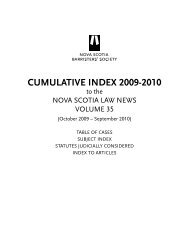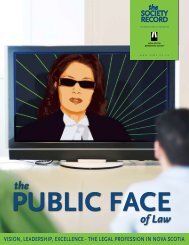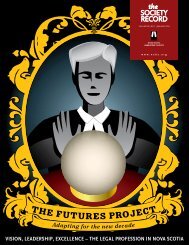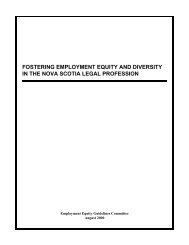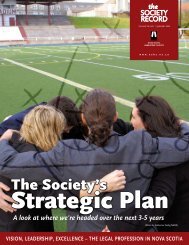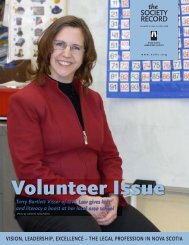SR Vol 27 No 4, October 2009 - Nova Scotia Barristers' Society
SR Vol 27 No 4, October 2009 - Nova Scotia Barristers' Society
SR Vol 27 No 4, October 2009 - Nova Scotia Barristers' Society
- No tags were found...
Create successful ePaper yourself
Turn your PDF publications into a flip-book with our unique Google optimized e-Paper software.
greater appreciation of the commonalities our communities share, suchas our pride in this province we call home and our desire to see it prosper.Why has there not been more progress in the appointmentof African <strong>No</strong>va <strong>Scotia</strong>n and Mi’kmaqlawyers to the judiciary in the last 20 years?Having now established that a representative judiciary matters, we mustscrutinize why we are not there yet. We have already seen that the problemis no longer one of numbers per se, since there are nearly 100 lawyersin the province who self-identify as Aboriginal or racially visible.Does the problem lie with qualifications? Lawyers appointed to theBench must possess a reputation for integrity, fairness, independenceand impartiality, and a demonstrated knowledge of the law. Surely, aswithin any sampling of 100 lawyers, there must be a certain percentageof the lawyers who self-identify as Aboriginal or racially visible who embodythe above qualities. I would argue that the problem lies not withthese lawyers lacking the qualities for judicial appointment but rather,with the criteria we use to measure these qualities.One criterion that we can see most readily as presenting barriers togreater appointment of Mi’kmaq and African <strong>No</strong>va <strong>Scotia</strong>n lawyers tothe Bench is years of standing at the Bar. The majority of Aboriginaland racialized lawyers in <strong>No</strong>va <strong>Scotia</strong> are graduates of Dalhousie LawSchool’s Indigenous Blacks & Mi’kmaq Initiative, created in 1989 inresponse to the Marshall Inquiry. Consequently, the majority of theselawyers are generally newer members of the Bar.The Federal Guidelines on Judicial Appointment require candidates topossess a minimum of 10 years at the Bar. The Provincial Guidelines wererecently amended in April <strong>2009</strong> to increase the minimum requirement ofyears of practice from 10 to 15 years at the Bar (though it should be notedthat both the Provincial Court Act, R.S.N.S. 1989, c. 238, s. 5 and FamilyCourt Act, R.S.N.S. 1989, c. 159 , s. 5 set the minimum at five years).The adverse impact resulting from setting the minimum years at the Bartoo high becomes obvious when we compare the number of Aboriginaland racialized lawyers eligible to compete at each of these minimums:Eligible lawyersfrom Aboriginaland racializedcommunities in<strong>No</strong>va <strong>Scotia</strong>5-yearminimum asper ProvincialCourt Act10-yearminimum asper FederalGuidelines15-yearminimum asper ProvincialGuidelines72 45 12I am not suggesting that it is wrong to require a minimum number ofyears within the profession as a measure of qualification for judicialappointment. However, if we recognize the importance of havingMi’kmaq and African <strong>No</strong>va <strong>Scotia</strong>n judges, we may have to considerbeing more flexible. This might include selecting a minimum that doesnot exclude the majority of eligible candidates from these communities(such as five or 10 years, as opposed to 15 years), or allowing knowledgeof the law to be measured by a combination of years of practice withsome other criteria that demonstrates a candidate’s qualifications.Another criterion for judicial appointment that can tend to createbarriers for African <strong>No</strong>va <strong>Scotia</strong>n and Mi’kmaq candidates is service tothe profession. Traditionally this would include writing of scholarly textsand articles on the law, teaching and presenting on the law, participatingin law reform committees and sitting on Bar Council. Lawyers fromhistorically disadvantaged communities may feel compelled invest theirvolunteer hours in ways that serve the particular communities they comefrom. Such service may not always be legal in nature. Even when it islegal in nature, such work may not be valued as highly as service thatcan be characterized as benefiting a particular area of the law, or a legalinstitution.While not a requirement for judicial appointment, there is a generaltendency to prefer lawyers in private practice, subject perhaps to theoccasional appointment of law professors to the Bench. This presentsparticular problems for Mi’kmaq lawyers. Many of the Mi’kmaq lawyersI know work as in-house counsel for Aboriginal organizations or FirstNation governments. In some cases, this is because the lawyer first triedprivate practice and had negative experiences, and found Aboriginalorganizations to be a more welcoming environment. In other cases,some Mi’kmaq lawyers simply see working at the grassroots level asthe best way to achieve positive change for Aboriginal people. Thereare more than 30 Mi’kmaq lawyers working in the province, yet onlyone in private practice, one with the Crown’s office and two with LegalAid. If we want more Mi’kmaq judges, the tendency to appoint lawyersfrom private practice may have to be reconsidered. At a minimum, thelack of retention of Mi’kmaq lawyers within private practice should beseriously studied by the profession.Finally, there may also be a tendency to view a specialization in an areaof law related to a minority community differently. This can hindera candidate from that community’s chances for judicial appointment.For example, I believe that a perception exists that specializations likeAboriginal law are “soft law” and not on par with more traditional areaslike tort or commercial law. A candidate for judicial appointment whospecializes in Aboriginal law may be viewed as less knowledgeable thana candidate who specializes in corporate commercial litigation. First,such a perception may not be warranted. During my time as a lawclerk at the Supreme Court of Canada, I recall one judge exclaimingthat Aboriginal law was one of the most difficult areas of law he hadever encountered. Second, if we believe that appointment of raciallyvisible judges matters, we will have to become educated about, and accordgreater value to, areas of non-traditional practice in which somecandidates may work.ConclusionThe above are some of the reasons why I believe there has been a lack ofprogress in appointing more Mi’kmaq and African <strong>No</strong>va <strong>Scotia</strong>n lawyersto the judiciary in <strong>No</strong>va <strong>Scotia</strong> in the 20 years since Recommendation 12was made. I would characterize the problem generally as a failure of theexisting evaluation criteria to account for the particular circumstancesand needs of Mi’kmaq and African <strong>No</strong>va <strong>Scotia</strong>n lawyers in theprovince. If we believe that having a judiciary that is representative ofour Mi’kmaq and African <strong>No</strong>va <strong>Scotia</strong>n communities matters, thensuch criteria should be reviewed to ensure they are sufficiently flexibleto meet the needs and circumstances of all lawyers in the province. Thiswould not result in “a lowering of standards” for judicial appointment.There are many different ways to measure the qualities we seek in ajudge. It is high time we start exploring these alternatives.<strong>October</strong> <strong>2009</strong> 37



